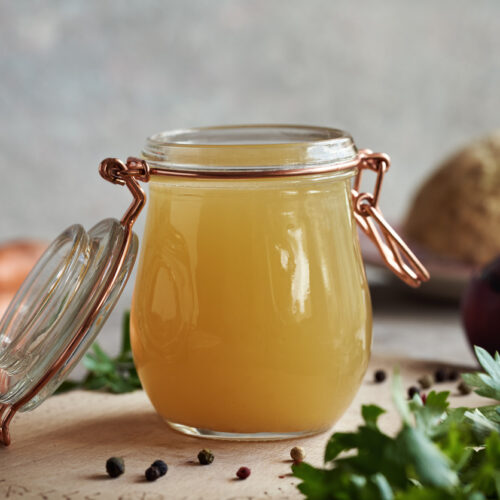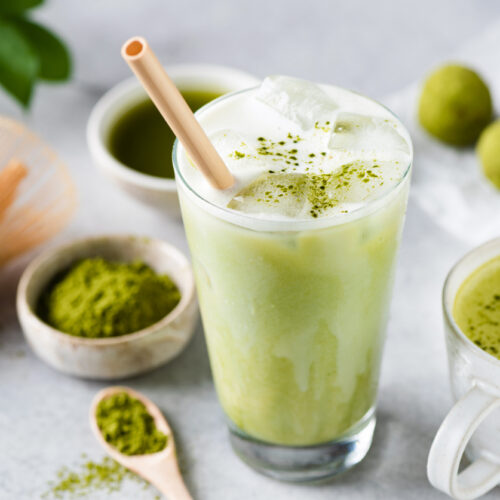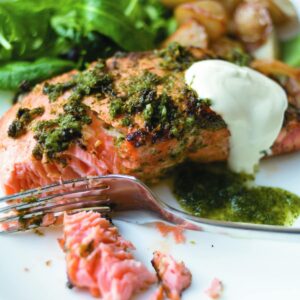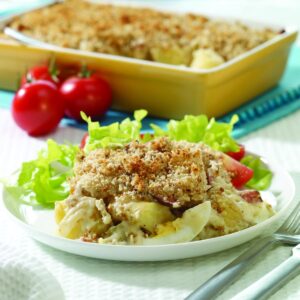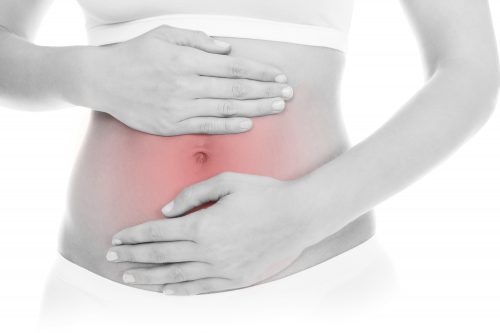
Dietitian Anna Richards — who specialises in food allergies and intolerances — unravels the possible causes of irritable bowel syndrome (IBS) and explains what you can do to find solutions to a grumbly gut.
Taming an irritable bowel is like shooting a moving target. The food tolerated today might upset next week with no real pattern.
Irritable bowel syndrome (IBS) accounts for around 40 per cent of gastroenterologist visits. It’s thought to be a Western issue and is more common in women, although it may also be that women are more proactive about seeking medical help in this area. There is often history of IBS in some families so genetics must play some part, too.
IBS encompasses a group of symptoms ranging from mild to severe irregular bowel motions, bloating, flatulence, abdominal discomfort, reflux and nausea, and may include one of the symptoms or sometimes all of them.
Is it IBS? Your five-step check
Diagnosing IBS — and identifying the cause — is really a process of elimination. It’s important to exclude other problems and serious issues before delving into food intolerance issues.
Step 1: Get checked
We really don’t know what causes IBS but factors such as stress, genetics, gastrointestinal infection and abnormal balance of bowel bacteria are all thought to be contributors. To start with though, it is prudent to see your doctor and ideally a gastroenterologist to confirm that there is nothing more serious than IBS such as inflammatory bowel disease or bowel cancer before self-diagnosing IBS. This may involve testing such as gastroscopy or colonoscopy, or blood tests.
Step 2: Check for coeliac disease
It is important to exclude coeliac disease when troubled by IBS symptoms. Around one per cent of the population have coeliac disease, an autoimmune disorder that often goes undiagnosed and presents with symptoms similar to IBS. Gluten, a protein found in wheat, rye, barley and oats causes an auto immune reaction, damaging the gut lining and impairing the absorption of many nutrients. Coeliac disease requires the lifelong exclusion of all gluten. With complete exclusion of gluten, the gut gradually heals and nutrient absorption improves. Undiagnosed coeliac disease can lead to a number of complications including infertility, miscarriage and osteoporosis.
A simple blood test is the first screening, which your doctor can arrange. It’s important to do this before you exclude gluten from the diet. Once gluten has been excluded the gut repairs and bloods return to normal making an accurate diagnosis difficult.
Step 3: Deal with stress
Stress is a recognised aggravator of IBS. Addressing stress and making room for sleep and exercise can go a long way towards taming IBS. If you know that these are issues for you, you might be surprised at how making some lifestyle changes can help — even without making any major diet changes.
Step 4: Investigate FODMAPs
Not that many years ago the IBS message was: you just have to live with it. But research over recent years has shown around 75 per cent of IBS sufferers respond to a low-FODMAP diet.
FODMAP is an acronym for Fermentable Oligosaccharides, Disaccharides, Monosaccharides and Polyols. This is a group of carbohydrates which are poorly absorbed by some people. The unabsorbed carbohydrates being rapidly fermented by gut bacteria cause the symptoms of irritable bowel.
Many IBS sufferers identify key trigger foods but still have continuing issues, unaware there are many other foods that also contain those carbohydrates which add up cumulatively to aggravate symptoms. It’s not just what was eaten in one meal, but across a day and potentially across a week.
There are five FODMAPs groups (click here for more detail on FODMAPs), each having the potential to cause problems. Initially it is unknown which groups are causing an issue, although it can often be the case that not all the FODMAP groups cause problems. To start with, though, it’s recommended to follow the full FODMAP diet for a month. A specialist dietitian may be able to tailor this a little more for you based on your history. It is important to remember this phase of the diet — known as elimination — while daunting, is diagnostic, and most probably not the end point! You won’t have to eat like this forever. It helps to look at what you can eat rather than what you can’t and life may feel a little easier.
No-one absorbs fructans (onions, garlic, wheat etc.), galactans (legumes) or polyols (stone and pip fruit, avocado, mushroom) particularly well. While not a problem for most people, these are best excluded when first undertaking a FODMAP diet. Fructose and lactose may or may not be an issue, but it’s best to exclude them initially.
It’s possible you may have some tolerance of some FODMAP groups. But as you won’t know this initially and often there is a very low tolerance, complete exclusion is best at the beginning. More recent research from Monash University has published likely levels of tolerance for a number of the FODMAP foods and has suggested small quantities may be tolerated, which is great news for people trying to include as wide a variety of foods as possible. Remember though, having several small doses of FODMAP foods in one meal may overload tolerance.
Step 5: Still no better? Investigate food chemical sensitivities
For a small number of IBS sufferers, it is possible for food chemical sensitivity to cause gastrointestinal symptoms. Symptoms triggered by food chemical sensitivity differ from person to person. Often people suffer from general unwell-ness and flu-like symptoms.
Amines are a food chemical occurring naturally in our most colourful, flavoursome foods, particularly concentrated forms such as tomato paste or orange juice. Amines also occur as protein food ages. Foods such as aged cheeses, preserved meats and pickles have long been recognised as provoking migraines and chronic headache. What is perhaps often missed is that these same foods can also trigger IBS symptoms in susceptible people.
Monosodium glutamate has been blamed for much and while some recognise they don’t feel well after meals containing MSG, what is often missed is the role of naturally occurring glutamate in aged and fermented foods such as soy sauce, with naturally occurring glutamate being chemically similar to MSG. Glutamate sensitivity can cause headaches, nausea and flushing as well as gastrointestinal symptoms.
Naturally occurring salicylate is highest in the most colourful, flavoursome and less ripe fruit and vegetables. It is related to aspirin. The role of salicylates and their link to specific conditions such as chronic urticaria and eczema is not certain. Those with salicylate sensitivity, however, often experience gastrointestinal symptoms in addition to their other issues such as mouth ulcers, hives and headaches.
Reduced salicylate diets have lost popularity over recent years, as they are restrictive of some of our most nutrient-laden foods. This is an area really best managed under close medical and dietetic supervision and more likely used as a diagnostic tool rather than for long-term management of symptoms.
Beware the pitfalls of self-managing IBS
Milk makes me feel unwell, I need a dairy-free diet
This may be the case — but is the problem lactose (milk sugar) or allergy (milk protein)?
Milk allergy is largely the domain of infants and young children with most achieving tolerance over their pre-school years. Many children (and adults) who have had a milk allergy never develop a liking for the taste or mouth-feel of milk, but this is very different to milk not liking them! Milk allergy does require the complete exclusion of milk initially with tolerance gradually achieved over time. It is possible but very unlikely for an adult who has previously consumed milk to develop a milk allergy and need to completely exclude milk from their diet.
The most common reason for adults to feel unwell after consuming milk, particularly if they have IBS, is an inability to digest lactose or milk sugar.
Lactose, the milk sugar (and one of the FODMAP foods), needs the enzyme lactase to break it down. Often after prolonged diarrhoea or with gut damage such as undiagnosed coeliac disease, less lactase is produced and is insufficient to break down all the lactose consumed. The undigested lactose is rapidly fermented by gut bacteria producing symptoms of nausea, bloating and loose bowel motions.
Lactose-free milk is now readily available in most supermarkets and will sit more happily in lactose intolerant tummies. While there is a hydrogen breath test available to assess lactose intolerance there is a long wait to be seen through the public medical system and the ‘pick up a bottle of lactose-free milk at the supermarket’ approach is very time effective and may save a lot of energy being spent following a milk-free diet. Dairy products such as hard cheese and butter are low in lactose and commonly tolerated as is a little yoghurt occasionally while avoiding major sources of milk in a latté or ice cream. Ice cream and yoghurt often have extra added milk solids which adds extra lactose.
Often, lactose tolerance increases again after a period of time with a settled gut.
I feel unwell when I eat bread or pasta, I must need a gluten-free diet
A gluten-free diet is designed for the management of coeliac disease and requires the lifelong complete exclusion of gluten, including crumbs in the butter and jam! It is a pretty big ask, if you don’t actually have coeliac disease. Many people report they feel a lot healthier when they don’t eat gluten but considering a gluten-free diet is usually cleaner with less processed food and more meat, fish, chicken, nuts and seeds, fruit and vegetables, it could be this is actually what’s making you feel better.
The low-FODMAP diet excludes larger quantities of wheat and rye but includes moderate intakes of oats, barley and small portions of wheat.
Most IBS sufferers find their symptoms significantly improve excluding large doses of our modern wheat such as bread and pasta, but also find they are just fine with a couple of crackers and certainly with crumbs in the butter. A gluten- free diet, while manageable for some, is a financial and social burden for others. It’s important to ask: do I need a completely gluten-free diet?
Gluten-free breads and pastas will certainly fit the bill but it could be worth exploring whether you tolerate spelt bread. Spelt is an ancient form of wheat more easily digested and absorbed than modern hybridised wheat. What we know as spelt is the wheat used to make bread and pasta in Europe. Many people who cannot tolerate wheat can tolerate spelt.
Steps to unravelling IBS
- Chat to your GP and arrange blood tests to exclude coeliac disease.
- Consider asking for a referral to a gastroenterologist to exclude more serious issues.
- Consulting an experienced dietitian who works with FODMAPs will certainly fast-track your mission as your history is very telling!
- If you decide to go it alone, make sure you work with reputable information. Monash University are leading researchers and have published a number of good books. The research is ongoing and the information changing, so make sure your information is current.
- There is a 75 per cent chance you will respond favourably to the FODMAPs diet, so it’s a good place to start but it will take some time.
- If you have a history of other health issues such as allergy, migraine or food chemical sensitivity, it is possible one of these may be contributing to your IBS but you will need to work with a specialist dietitian as self-diagnosis can lead you up the garden path!
Irrespective of whether you have an issue with FODMAPs or food chemical sensitivity, it is well documented that stress, fat, caffeine and alcohol are aggravators. Perhaps these are best addressed first before dietary restriction as reducing fat, caffeine, alcohol and stress won’t do any of us any harm!
Remember: IBS is a fickle beast and will change over time. Don’t be regimented and be prepared to change with it. Seek help if your symptoms are not improving or you find yourself tempted to keep removing more food groups.
Why eating completely FODMAP-free is not the answer
When people have success with a FODMAP-free elimination diet and feel much better, it’s tempting to not want to reintroduce FODMAP-containing foods. There are some downsides to this, though.
We don’t really know what effect the long-term exclusion of FODMAPs may have, particularly in relation to gut bacteria. FODMAP-containing foods also act as prebiotics which feed the good bacteria in our guts, and excluding these could change the makeup of our gut bacteria (see HFG March 14 for more on this). It’s important to eat to your tolerance. The ideal situation to get to is to be able to eat small amounts of lots of foods, including those containing FODMAPs. This is a good goal for anyone struggling with IBS.
Can low-FODMAP diets help other conditions?
There is a strong link between IBS and conditions such as endometriosis and polycystic ovaries with many women finding their symptoms significantly improved following a FODMAP diet. Recent evidence has shown those who suffer from inflammatory bowel disease such as Crohn’s disease may also respond to a FODMAPs diet.
www.healthyfood.com


